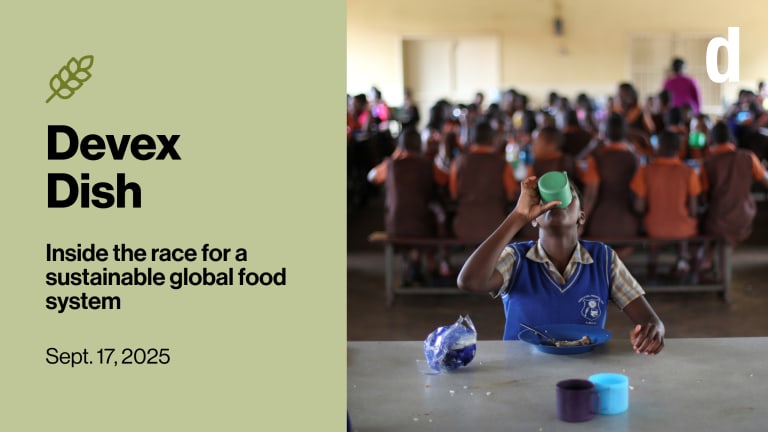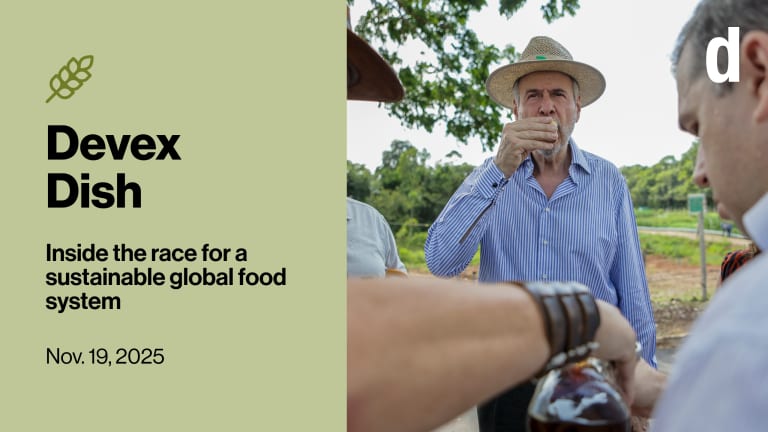Presented by CGIAR

Since last summer, the El Niño weather phenomenon has wreaked havoc on agricultural production worldwide. That is prompting some governments to act quickly to build their climate resilience.
This is a preview of Devex Dish
Sign up to this newsletter to get the inside track on how agriculture, nutrition, sustainability, and more are intersecting to remake the global food system in this weekly newsletter.
El Niño is caused by warmer sea surface temperatures. It occurs on average every two to seven years and typically lasts about a year. In some areas it causes drought and in others, heavy rain.
Southern Africa is experiencing a particularly brutal El Niño season, with one of its driest Februarys in 40 years and widespread crop failures. The governments of Zimbabwe, Zambia, and Malawi have all declared national disasters due to El Niño-linked droughts. Last month, Zimbabwean President Emmerson Mnangagwa said the country would need $2 billion to feed the 2.7 million people who would go hungry this year.
El Niño has proved painful for one Zimbabwean farmer. Moses Kumbweya has traditionally relied on rainfall to grow cash crops like lettuce for local markets. He has weathered many El Niño events in years past. But the effects of climate change have made this year’s El Niño more dangerous compared to the one in 2012, he says.
“So far I have lost about 10,000 crops of lettuce, which is around $6,000. As for maize, $1,200 was for maize seed and $800 for fertilizers. So, I lost roughly $8,000,” he tells Devex contributor Lungelo Ndhlovu.
A “greenhouse warming-related effect” has led to stronger and more frequent El Niño and La Niña events since the 1960s, causing unusual droughts, floods, and heat waves worldwide, according to a study in the journal Nature.
Zimbabwe’s government is now discussing a climate change law to advance mitigation and adaptation measures, though civil society leaders say they haven’t been properly consulted. “Climate change mitigation is a national food security issue which must be taken seriously,” economic specialist Vincent Musewe tells Lungelo.
Read: As El Niño bites, Zimbabwe takes aim at climate change with new law
Background reading: What is El Niño and how does it impact food security around the world?
From the ground up
Healthy food systems start with healthy soils. This week, the African Fertilizer and Soil Health Summit takes place in the Kenyan capital of Nairobi. The three-day summit has brought together more than 4,000 delegates to examine the decline in African soil quality and adopt a plan that will guide fertilizer and soil policy for the next decade.
The summit — organized by the African Union along with the Kenyan government — comes at a time when nearly 282 million people in Africa, or about 20% of the population, are undernourished despite the continent containing some 60% of the world’s available arable land. At the same time, African agricultural yields are among the lowest globally due to factors including poor soil fertility and low use of fertilizers.
During the event’s opening on Tuesday, Josefa Sacko, the African Union commissioner for agriculture, rural development, blue economy, and sustainable environment, spoke of the need to “build food sovereignty in Africa by raising the productivity with a view to feeding 2.4 million people by 2050.” The event hopes to address barriers to fertilizer use on the continent — among them, the high costs of fertilizer, low investment in local fertilizer production, and finance for investment in the fertilizer trade.
Sorting out the financing will be critical to the summit’s success. According to the AU, $15 billion in private sector investment is needed to increase local manufacturing of mineral fertilizers.
But there’s also a substantial debate on what the future of African agriculture should look like — and to some, it doesn’t include chemical fertilizers.
The Alliance for Food Sovereignty in Africa, a coalition of more than 41 African civil society groups, has called for changes to the AU’s 10-year action plan. Its “strong emphasis on the extensive use of mineral fertilizers, hybrid seeds, and agrochemicals is seen by AFSA as a continuation of outdated and potentially harmful practices,” AFSA said in a statement. “These methods misinterpret the real challenges of soil health and risk exacerbating soil degradation, threatening food security, public health, and crucial seed diversity in Africa.”
The group advocates for agroecology, the practice of integrating local knowledge with scientific innovation to restore biodiversity and build resilient food systems.
But to the AU’s Sacko, fertilizers are integral to the continent’s food security.
“The slogan of the event, ‘Listen to the land,’ looks to explore the current condition of Africa’s soils with the mindset that multiple solutions — including fertilizers — exist and must be implemented rapidly to avert the worsening food and nutrition security in Africa,” Sacko said.
In addition to the 10-year action plan, the expected outcomes of the summit are the endorsement of the Nairobi Declaration on fertilizer and soil health by heads of state, as well as the launch of the Soil Initiative for Africa. Devex contributor Anthony Langat is at the summit this week, so stay tuned for more updates.
Related reading:
• Why soil is the fundamental building block of food security (Pro)
• Food crisis: Mineral fertilizers 'here to stay,' says IFDC (Pro)
+ Not yet a Devex Pro member? Access all our exclusive reporting and analyses, data-driven funding insights, invite-only events, and the world’s largest global development job board by starting a 15-day free trial today.
A private sector matter
Bringing home the bacon
Your next job?
Chief of Party
World Initiative for Soy in Human Health
Tanzania
A major United Nations summit set for December has put the global business community on notice that it’s straining the world’s land and forests.
This year’s conference of the United Nations Convention to Combat Desertification, or UNCCD, aims to get the private sector to meaningfully contribute both money and solutions to the problem of overexploitation of natural resources. It will be held in Riyadh, Saudi Arabia, in December.
“By and large, land degradation is caused by the industry, the private sector, and by our activities as human beings. The private sector contributes to our overall well-being. They should make sure their production is sustainable but also for the sake of the planet,” UNCCD Executive Secretary Ibrahim Thiaw tells Devex contributor David Njagi.
Read: COP 16 desertification summit to target private sector’s overuse of land
Number munching
45%
—That’s the percentage of Gaza’s agricultural land that has been damaged since the start of the conflict with Israel, according to UNOSAT, the United Nations Satellite Centre. Israel’s bombing campaign is destroying the ability of Gazans to grow their own food, while also blocking a majority of international food aid from entering the territory. Before the war, agriculture accounted for nearly half the territory’s land area.
Last weekend, World Food Programme Executive Director Cindy McCain said she believes parts of northern Gaza are in a “full-blown famine.”
ICYMI: Why famine is 'inevitable' in Gaza — and what's next
+ Catch up on our coverage of the humanitarian crisis in Gaza.
Chew on this
A comprehensive new World Bank report shows how global agrifood systems can cut greenhouse gas emissions — and halving current emissions by 2030 will require annual investments to increase 18 times to $260 billion per year. [World Bank]
Sudan is on the brink of a “mass atrocity” against non-Arab ethnic groups as the conflict, invisible to much of the world, forces some 5 million people into famine, U.S. lawmakers were told during a hearing with the U.S. special envoy to Sudan last week. [Devex]
The U.S. has committed $200 million for the procurement and distribution of ready-to-use therapeutic food to treat acute malnutrition worldwide. [USAID]
A new science lab at the University of Essex is developing climate-resilient plants to ensure future food security. [The Independent]
Anthony Langat contributed to this edition of Devex Dish.








